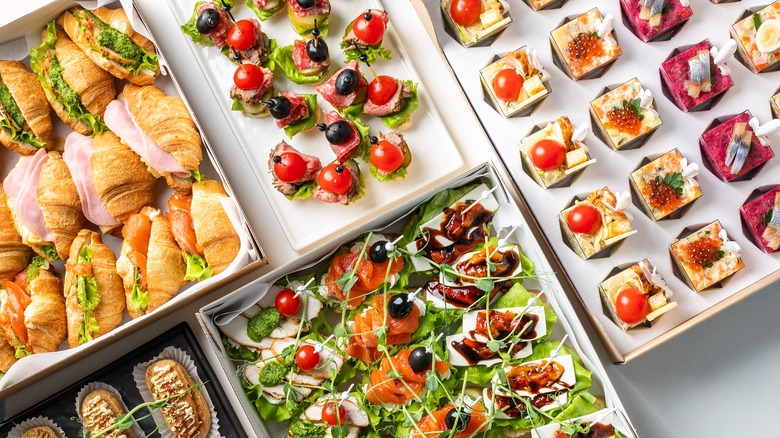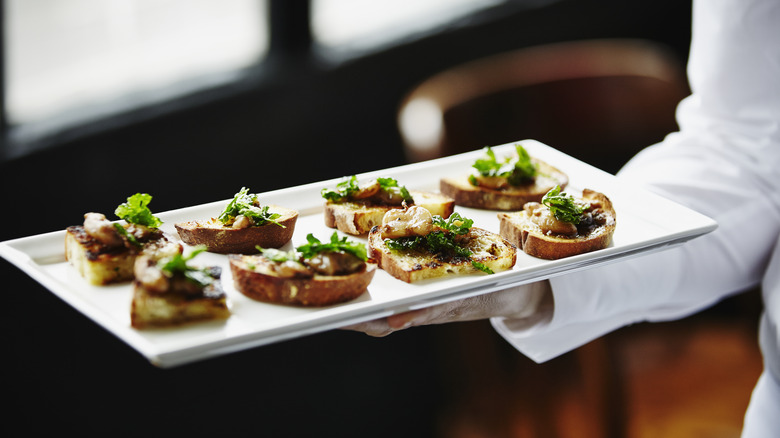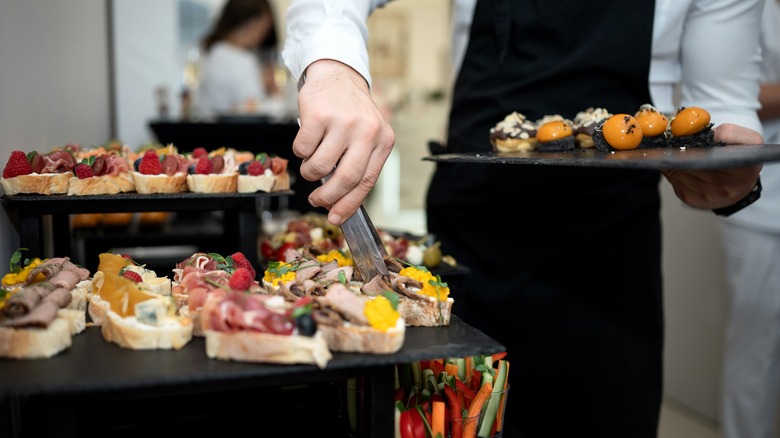Canapés Vs Hors D'oeuvres: What's The Difference?
While guests eagerly anticipate the main course at a sit-down dinner or large gathering, having small bites available to enjoy beforehand is always a nice touch. Some may call them appetizers, and others refer to them as hors d'oeuvres, starters, or even canapés. While all of these terms are often used interchangeably when referring to the tasty tidbits that are passed around during the first course, they actually have very different meanings. Whether you are a host or a guest at an event, it is important to understand the difference between these dishes so you know exactly what you are in for.
Hors d'oeuvres is a French term that translates to "outside of work," referring to the small bite intended to be enjoyed separately from the main course. Hors d'oeuvres is used as a blanket term that includes many different types of individually portioned dishes that come in a wide range of flavor profiles and serving styles, from kebabs and crudities to canapés. In fact, canapés are one of the many different types of hors d'oeuvres, consisting of a small piece of toasted bread or a cracker topped with spreads, cheese, meat, vegetables, or other garnishes.
Not all hors d'oeuvres are canapés, but all canapés are hors d'oeuvres
While the term hors d'oeuvres encompasses a wide range of small bites, canapés are distinctly defined by their structure and style. The word canapés is actually French, meaning "sofa"; this is likely a reference to the way that toppings sit on top of the cracker or bread. The tiny, open-faced sandwich of sorts can contain both sweet and savory flavors in the same bite, including everything from smoked salmon and cucumber to prosciutto and melted brie.
Eating a fancy canapé can make you feel like you're at a royal wedding, but they aren't actually that difficult to make, and high-end ingredients are not a requirement. When it comes to a successful tray of the tasty finger food, it's all about presentation. Pickled fig and ricotta canapés might sound like the most complex hors d'oeuvre ever, but in reality, they consist of a cracker, ricotta cheese spread, half a fig, and crushed up pistachios that have been smartly arranged for easy transport from a tray to your mouth. You can also turn popular spreads like bruschetta and spinach artichoke dip into canapés by adding them to small servings of toasted bread, then sprinkling on garnishes like spices or bits of cheese to elevate their appearance. There are no exact rules for what you can and cannot add to a canapé. However, they should be structurally sound enough to be passed around without falling apart, and most importantly, they should be small enough that guests can enjoy them in one bite.
Hosting tips for serving all types of hors d'oeuvres
Hors d'oeuvres are the perfect addition to a Thanksgiving dinner menu or snack passed around during a fancy New Year's Eve party. The small bites are so widely enjoyed that many hosts have started forgoing a main course altogether in favor of multiple different types of hors d'oeuvres for guests to enjoy throughout the event. If you decide to incorporate hors d'oeuvres in any way during your event, there are a few things to keep in mind while planning.
Consider offering a wide range of small dishes that incorporate various flavor profiles and textures. A warm tomato soup shooter served alongside crispy grilled cheese bites will pair nicely with a cold cocktail shrimp option and a canapé topped with chilled, smoked salmon and cucumber. It is also important to accurately calculate how many of each hors d'oeuvre you need to prepare. Plan for each guest to enjoy between two and three small bites if you are also offering a larger meal. However, if hors d'oeuvres are the only food options being offered to guests, each person will likely indulge in up to six bites within the first hour, plus an extra few each hour afterwards for the duration of the party.
Having hors d'oeuvres passed around on trays is a great way to elevate your event's ambiance and encourage guests to try the snacks as they pass by. You can also serve the small bites buffet-style, which will allow guests time to try each one and eat at a comfortable pace.



